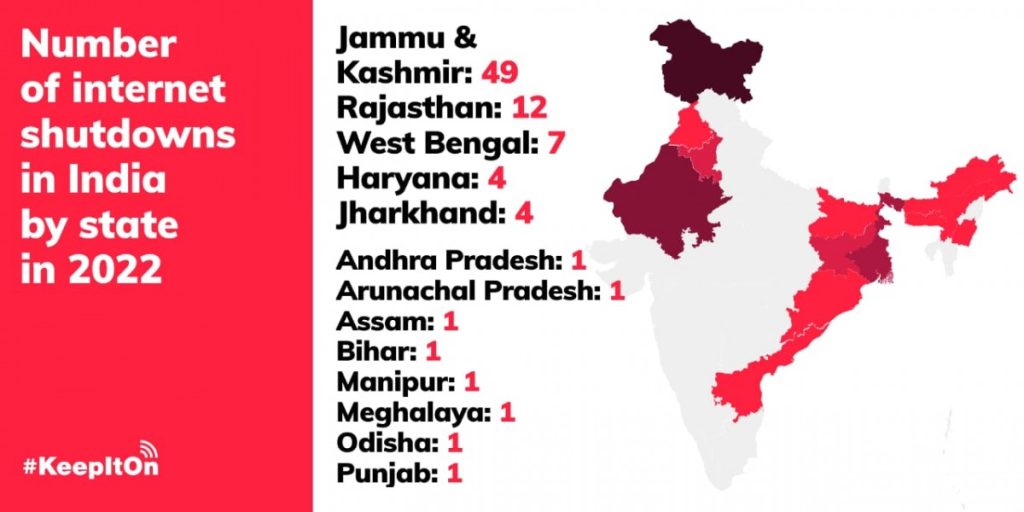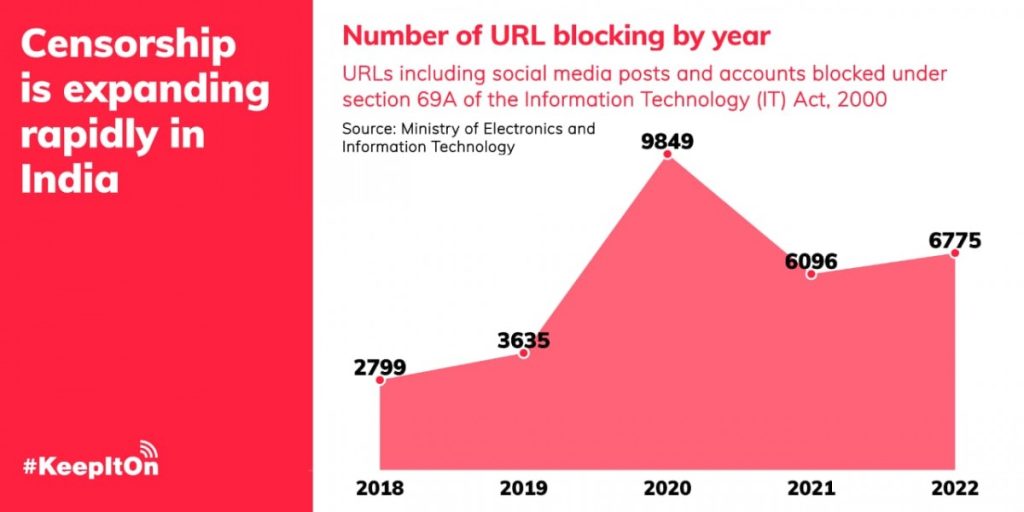CONTENTS
- Measuring Internet Freedom in India in the Last 10 Years
- Navigating the Legal and Ethical Implications of AI
Measuring Internet Freedom in India in the Last 10 Years
Context:
Over the past five years, India has consistently ranked first globally for imposing internet bans, accounting for approximately 60% of all recorded blackouts worldwide between 2016 and 2022. State-initiated shutdowns in the last decade have typically cited reasons of national security and concerns over public order. However, rights organizations argue that these shutdowns often contravene court directives.
Relevance:
GS2
- Fundamental Rights
- Right to Information
Mains Question:
What is the legislative framework governing internet shutdowns in India? What effect can internet bans have on the right to freedom in a country that holds the distinction of being the world’s largest democracy? (15 Marks, 250 Words).
Relevant Statistics:
- According to data compiled by the Software Freedom Law Centre (SFLC), the Indian government enforced a total of 780 internet shutdowns from January 1, 2014, to December 31, 2023.
- Notable surges in shutdowns occurred during protests against the Citizenship Amendment Act in 2019, the revocation of Article 370 in 2019, and the introduction of Farm Bills in 2020.
- In 2020, disruptions to internet services in India accounted for over 70% of the global economic losses attributed to such shutdowns. In 2023 alone, India experienced internet shutdowns totaling over 7,000 hours.
- Globally, the reasons behind internet shutdowns vary, with protests being the most frequent cause, followed by efforts to control information and instances of political instability.
- According to data from the Software Freedom Law Centre (SFLC), over the period from 2015 to 2022, more than 55,000 websites were subjected to blocking.
- In the past 12 years, the region of Jammu and Kashmir experienced the highest number of shutdowns, totaling 433 instances.
- Notably, Manipur endured the longest blackout in 2023, lasting from May to December, amidst ethnic tensions.
- As of February 15 this year, internet shutdowns were ongoing in Haryana amidst the farmers’ protests.

Legislative Framework on Internet Bans:
- As per the Indian Telegraph Act, Indian states and Union Territories are authorized to impose internet shutdowns only in cases of “public emergency” or for the sake of “public safety.” However, the law does not specify what qualifies as an emergency or safety concern.
- In the landmark case of Anuradha Bhasin v. Union of India, the Supreme Court ruled that internet shutdowns infringe upon fundamental rights to freedom of expression, declaring indefinite shutdowns unconstitutional.
- Additionally, courts have mandated that governments make shutdown orders public, although compliance with this provision has been noted to be inadequate by experts.
- A British-era statute was utilized by the Union government to suspend mobile internet in Punjab, as farmers from the state staged protests in Delhi.
- The majority of content censorship occurred under section 69A of the IT Act, carried out by the Ministry of Electronics and Information Technology and the Ministry of Information and Broadcasting.
- URLs were typically blocked due to their association with organizations banned under the Unlawful Activities (Prevention) Act.
The ‘Three-Part Test’:
- Activists have criticized India for not meeting the criteria of the ‘three-part test’ when implementing blackouts in Jammu and Kashmir and Manipur. According to international law, before blocking access to content or implementing coercive measures that infringe upon people’s fundamental rights, countries must assess whether the action is legally provided for, serves a legitimate purpose, and adheres to standards of necessity and proportionality. The majority of internet shutdowns over the past decade have been localized to specific districts, cities, and villages.
- Notably, the Ministry recently instructed the news outlet The Caravan to remove a story alleging abuse, torture, and murder of civilians by the Indian Army in Jammu’s Poonch district.
- On social media platforms, nearly 30,000 social media URLs, including accounts and posts, were blocked between 2018 and 2022. The majority of these requests were directed to X.

- The escalating threat of cybercrime poses a significant challenge for websites. In contrast to the 5,693 cases reported in 2013, India witnessed a staggering increase to over 65,000 cases last year, marking a rise of nearly 434% between 2016 and 2022, as reported by the National Crime Records Bureau.
Way Forward:
Enhancing the Existing Framework:
Strengthening the legal and regulatory framework governing internet shutdowns to ensure they are employed only as a last resort, in line with international human rights norms.
Revision of Outdated Legislation:
Amending the Telegraph Act and its associated regulations, which are antiquated and ambiguous, to align them with constitutional and human rights standards.
Establishing Accountability Mechanisms:
Enhancing transparency and accountability among authorities responsible for ordering and executing internet shutdowns, while also providing effective avenues for redress for those impacted by such actions.
Exploring Alternative Measures:
- Exploring less intrusive strategies to address disturbances related to law and order, communal violence, terrorist activities, examinations, and political unrest.
- Options may include targeted website or content blocks, issuing warnings or advisories, engaging with civil society and media, or deploying additional security personnel.
Adhering to Supreme Court Directives:
Complying with the directives outlined by the Supreme Court in the Anuradha Bhasin case (2020), which stipulate that internet shutdowns should be temporary, proportionate, and subject to judicial review under the Suspension Rules.
Conclusion:
Both India and global trends indicate concerning developments. According to the latest report from Freedom House, global Internet freedom has continued to decline for the 13th consecutive year, with the online environment for human rights deteriorating in 29 countries. India’s ranking has remained relatively consistent over the past three years, experiencing a decline from 59 points in 2016 and 2017 to 50 points in 2023.
Navigating the Legal and Ethical Implications of AI
Context:
In an era increasingly shaped by Artificial Intelligence (AI), the fundamental inquiry shifts from AI’s capabilities to its permissible applications. This contemplation critically evaluates AI’s potential to reconfigure our lives within ethical and legal frameworks. As we navigate the expansive terrain sculpted by AI, it is imperative to ensure that our technological progress is complemented by a profound commitment to ethical accountability.
Relevance:
- GS3- Awareness in the fields of IT, Space, Computers.
- GS4- Ethical Concerns and Dilemmas.
Mains Question:
In a world increasingly shaped by Artificial Intelligence, the discourse shifts from its capabilities to the imperative question of its ethical boundaries. Analyse. (10 Marks, 150 Words).
Legal and Ethical Complexities and AI:
- The emergence of AI stands as a testament to human creativity, offering transformative opportunities across virtually every facet of our existence. However, alongside its transformative potential, AI introduces a spectrum of legal intricacies that warrant careful examination.
- The evolution of legal doctrines in response to AI’s rapid advancement assumes paramount significance, addressing concerns ranging from privacy and data protection to intellectual property rights and employment dynamics.
- Nevertheless, the journey towards realizing AI’s full potential is riddled with challenges that necessitate vigilant oversight and a principled approach to regulatory frameworks and ethical considerations.
- On a global scale, AI elicits inquiries that transcend geographical boundaries, presenting legal and ethical quandaries that necessitate comprehensive resolution.
- AI’s capacity to analyze and utilize vast troves of personal data has prompted a reevaluation of existing privacy regulations worldwide, prompting nations to adopt robust data protection measures.
- Examples include the European Union’s General Data Protection Regulation (GDPR) and India’s Digital Personal Data Protection Act 2023, both aimed at safeguarding personal information while fostering digital innovation.
AI and Labour Market:
- The impact of AI on the labor market necessitates careful consideration. The potential for automation to replace jobs underscores the urgency of implementing legal frameworks that can mitigate adverse effects and prepare the workforce for an AI-dominated future.
- Similarly, the convergence of AI with intellectual property rights challenges traditional concepts of creativity and authorship, demanding legal innovations that acknowledge and safeguard the contributions of all stakeholders, including those made by AI.
Bias and Discrimination in AI:
- Concerns regarding bias and discrimination in AI underscore the crucial importance of ensuring that technological systems are as impartial and inclusive as possible.
- The development and deployment of AI must be guided by anti-discrimination laws tailored to the digital era, guaranteeing fairness and equity in its application.
AI Governance:
- Internationally, regulatory approaches to AI vary significantly, with entities such as the European Union adopting comprehensive frameworks while others pursue more sector-specific guidelines.
- This diversity underscores the intricate interplay of legal, cultural, and societal factors shaping AI governance, emphasizing the necessity for a globally coordinated dialogue on AI ethics and regulation.
- The integration of AI into the legal profession provides a glimpse into the future, demonstrating AI’s potential to enhance legal analysis, predict outcomes, and even aid in judicial decision-making.
Way Forward:
- The Indian Government’s embrace of AI, evidenced by initiatives such as “Digital India” and the formulation of a National Strategy for Artificial Intelligence, underscores a forward-thinking approach towards leveraging technology for societal welfare.
- As AI continues to evolve rapidly, it becomes essential for societies, particularly within the diverse context of India, to engage in proactive discourse.
- We must anticipate future developments and craft legal frameworks that are adaptable to the unpredictable technological landscape, ensuring that the benefits of AI reach all segments of society.
- As we navigate the integration of AI into the legal sphere, our primary focus should remain on developing and refining laws that safeguard human rights and uphold human dignity.
- Achieving a balance between advancing technology and legal principles necessitates a culture of continual learning and adaptation, where laws are not only reactive to AI challenges but also anticipate and embrace its extensive possibilities.
Conclusion:
With India positioned as a leader in AI innovation, supported by progressive policies and abundant intellectual resources, we have the opportunity to spearhead the global dialogue on ethical AI. As we delve deeper into this uncharted territory, our collective objective should be to envision a future where technology enhances the loftiest aspirations of law and justice, while legal frameworks foster the responsible advancement of Artificial Intelligence.





